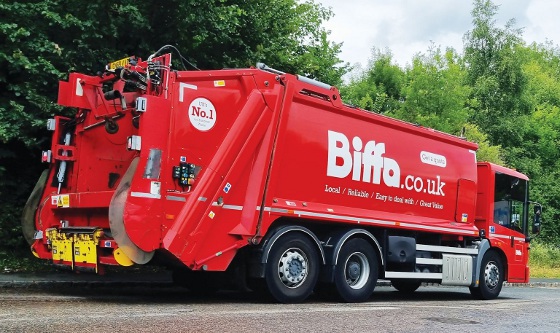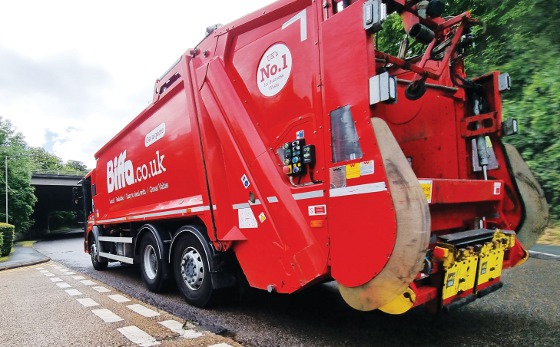 |
| August 02, 2022 | Volume 18 Issue 29 |
Designfax weekly eMagazine
Archives
Partners
Manufacturing Center
Product Spotlight
Modern Applications News
Metalworking Ideas For
Today's Job Shops
Tooling and Production
Strategies for large
metalworking plants
Specifying different axle ratios could cut fuel bills for some fleet vehicles

Leading UK waste management company Biffa recently worked with Allison Transmission to determine optimal axle settings for Mercedes-Benz Econic trash-collection trucks with 270-, 300-, and 350-hp engines. [Credit: Allison Transmission]
New research by Allison Transmission, the world's largest manufacturer of fully automatic transmissions for medium- and heavy-duty commercial vehicles, has revealed that many commercial vehicle fleets could cut their fuel consumption by requesting different axle ratios to those routinely offered on new vehicles.
Allison says making this simple change to a truck's specification should not add any additional cost, but it can bring "a valuable reduction in running costs and carbon emissions." Savings are likely to be greatest on duty cycles with frequent stop-starts around town or on minor rural roads.
Leading UK waste management company Biffa recently worked with Allison to determine the optimal axle settings for Mercedes-Benz Econic trash-collection trucks with 270-, 300-, and 350-hp engines. By running simulations on its iSCAAN software program, Allison identified that switching these trucks from the standard 6.84:1 axle ratio to a shallower 6.0:1 ratio, also offered by Mercedes-Benz, could reduce fuel consumption by up to 3% and lower cab noise to boot.
As a result, Biffa has amended its current order of 20 new Mercedes-Benz Econic trash-collection vehicles, due to be delivered this autumn, with a further order of 18 to follow in spring 2023.

Pictured left to right in front of a Mercedes-Benz Econic trash-collection vehicle operated by Biffa: Darren Judd, Biffa's head of Fleet Development, Nathan Wilson, Allison Transmission's UK account & market development manager, and Steve Cole, group Fleet & Procurement director at Biffa. [Credit: Allison Transmission]
Other simulations by Allison have shown that adopting axle ratios numerically lower than those offered as standard by OEMs can reduce fuel consumption by 1 to 3%. This can be achieved without negatively affecting the vehicle's launch gradeability or productivity, thanks to Allison's Continuous Power Technology, which is its torque converter tech that nearly doubles engine torque at launch and delivers power to the wheels without interruption when shifting.
"Vehicle OEMs typically offer their fleet customers a choice of two or three factory-fit axle ratios and recommend one of these according to the country of use and application, making a sensible balance between performance and economy," said Nathan Wilson, Allison's UK account and market development manager. "Historically, a deeper axle ratio setting has been the default selected by OEMs to provide the best gradeability for a 30 percent and above incline. While this delivers a good fit for many customers, in reality, gradients of this extreme are rarely encountered on UK roads. Meanwhile, the pressure to reduce costs and environmental impact has taken center stage in recent years."
"We recommend axle ratio reviews when ordering new vehicles, which in most cases will not cost any more to buy, yet will cost less to own and operate," added Wilson.
"As a rule of thumb, every one percent fuel cost saving equates to a 100-rpm reduction. This might not sound like much, but over many vehicles and years it all adds up," said Darren Judd, Biffa's head of Fleet Development.

Allison identified that switching from the standard 6.84:1 axle ratio to a shallower 6.0:1 ratio, as offered by Mercedes-Benz, could reduce Biffa's fuel consumption by up to 3%, without negatively affecting the vehicle's launch gradeability or productivity. [Credit: Allison Transmission]
Allison's iSCAAN (internet System for Computerized Application Analysis) program optimizes vehicle configurations, evaluates vehicle acceptability, and predicts vehicle performance for more than 20 vocational applications. Through matrix analysis, iSCAAN quickly evaluates changes to driveline ratios and shift calibration features. Furthermore, through simulation tools, iSCAAN evaluates the performance or fuel economy of Allison features, such as the company's Acceleration Rate Management and FuelSense 2.0.
In 2021, Allison announced the retrofitting of its FuelSense 2.0 software to Dennis Eagle and Mercedes-Benz Econic trucks operated by Biffa. This aftermarket order, now at 540 trucks and the largest of its kind within the EMEA (Europe, the Middle East, and Africa) region, followed a six-month trial in which Biffa found that FuelSense 2.0 Max delivered fuel savings of up to 9% and a reduction of approximately 4,500 kg of CO2 per year. This equates to approximately a £600,000 ($730,500) reduction in fuel expenditure per annum.
In 2020, Allison revealed that savings of £200,000 (almost $250,000) per year on truck transmission servicing costs were planned to be achieved by Biffa as a result of advice provided by Allison to extend intervals for the renewal of transmission fluid and filters on its Dennis Eagle trucks. In addition, Biffa predicted savings of 3,600 hours in labor and vehicle downtime annually.
Source: Allison Transmission
Published August 2022
Rate this article
View our terms of use and privacy policy
